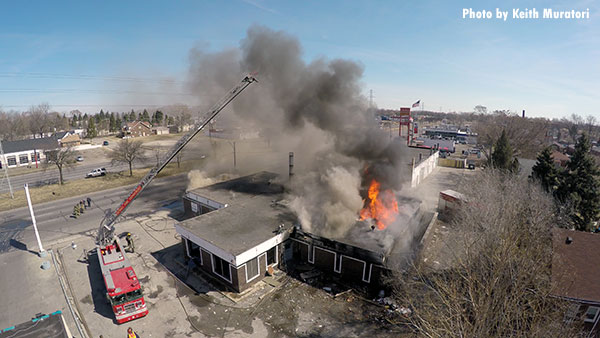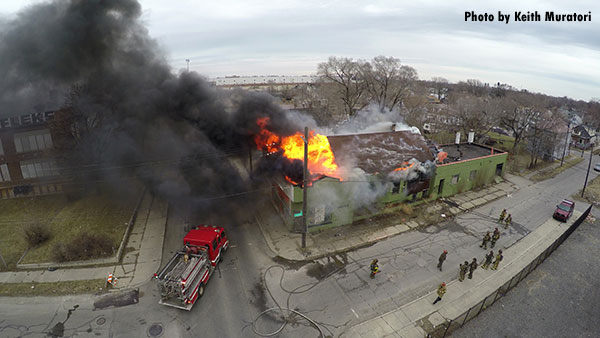This month we take a look at the work of fireground photographer Keith Muratori of Connecticut, whose drone photo graced the January 2015 cover of Fire Engineering magazine.
FE: What got you started in fire photography?
I really got serious about fire photography when I was hired by the Bridgeport (CT) Fire Department back in 2000. I was always interested in photography growing up, and seemed to photograph the things that interested me at the time. Once I became a career firefighter, my photographic motivation turned to fireground action. Early in my fire photography I was inspired by Bobby Pressler and John Cetrino’s yearly FIREGROUND Calendar, Bill Noonan’s books, and Bill Eisner. Since then, I have shot many things along the way, but nothing gives me satisfaction like covering a fire scene. It ranks high above all of my other photography subjects and I am sure that it always will.
FE: What kind of equipment do you use?
Since becoming serious with fire photography around 2000, I have always used Canon gear. Currently I am shooting a Canon 5D Mark III with a Canon 24-105mm L series lens as my work horse. For night incidents, I run a Canon 580 EX II flash. I have a Canon 1D Mark III body for a back up. Other lenses include a 24-70mm 2.8 L series and a 70-200mm 2.8 L series zoom.
Most recently, my fire photography has grown to include aerial images and high definition video by drone. My current drone at this time is a DSLRPros built DJI Phantom 2 Sundance Cinema Edition Kit. The camera mounted to the stabilizing gimbal on the drone is a GoPro Hero 4 Black Edition. I shoot all fires with this camera set to 4K (two steps above the common 1080p HD) to get the highest resolution that I can.


FE: What have been some of more memorable jobs?
One of my most memorable jobs would have to have been last fall on September 11 in Bridgeport, Connecticut. It was the Seaview Avenue multiple-alarm fire. It was also the first large night fire that I flew the drone over. The assignment would go to the equivalent of a fifth alarm. The warehouse, located at 2102 Seaview Avenue, housed a perfume factory as well as a roofing company. Chemicals stored in upwards of 55,000 barrels exploded like fireballs into the night sky. Runoff from the firefighting operations had also caused a massive problem in the surrounding bodies of water. Coast Guard and D.E.P. were investigating the reach of the damage into the water. Radiant heat from the blaze had police and fire evacuating people from neighborhoods close to the fire. Other memorable fires for me would have been on my trips to photograph the Detroit Fire Department.
FE: What’s unique about the area you cover–the place, the firefighters, the hazards, etc?
I cover a very diverse firefighting area. I cover Bridgeport, which is the largest city in Connecticut and has your typical “city” firefighting, housing, industry, and problems associated with big cities. Surrounding the big cities such as Bridgeport and New Haven are several smaller suburban towns manned with volunteer firefighters which offer different structures. And of course, Connecticut is in New England, so we get the extreme seasons to deal with, both in firefighting as well as fire photography.
FE: What have been some of your more memorable publications?
My most memorable publications would have to have been my fire service magazine covers…all four have been with Fire Engineering. My most memorable has been this past January 2015’s cover from the Delaney’s Pub Fire in New Haven, Connecticut. It was the first ever major fire service magazine cover shot by drone.
FE: Any advice to aspiring fire photographers?
Keep yourself safe on the fireground. Be aware of your surroundings and do not get in the way. Practice as much as possible and shoot as many incidents as you can. Early on, it’s the smaller incidents where you will probably get your most experience. The stress level will be lower and you can think about what you are doing and what settings to use. This way, when you finally show up to a major, chaotic incident, your camera and flash settings will start to have become second nature and you can work on the composition of your shots.
See more of Keith’s work at FIREGROUNDIMAGES.COM.
MORE KEITH MURATORI


